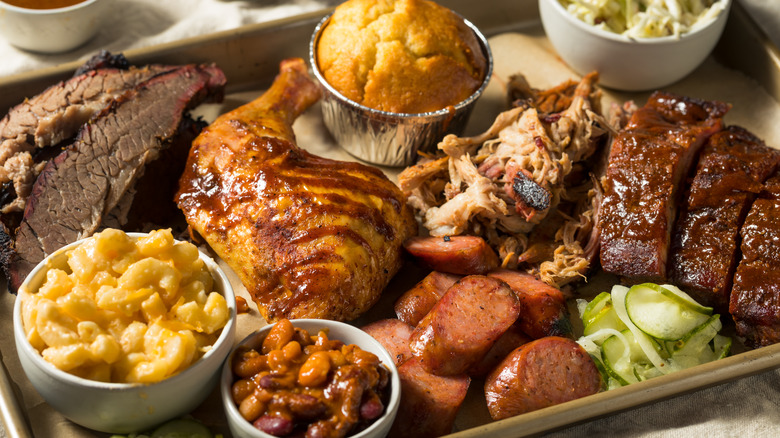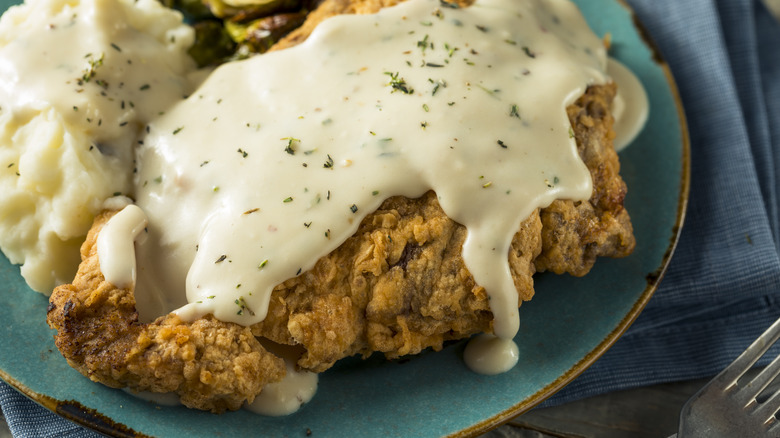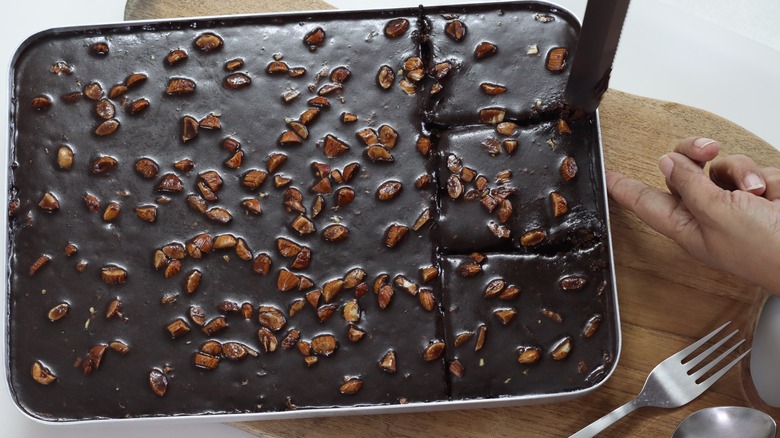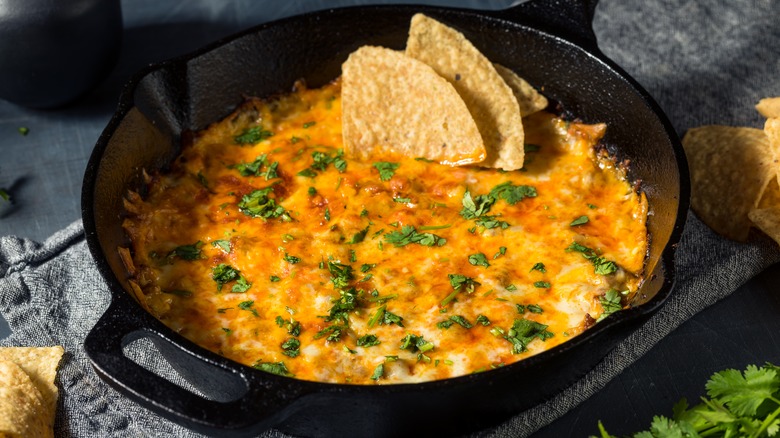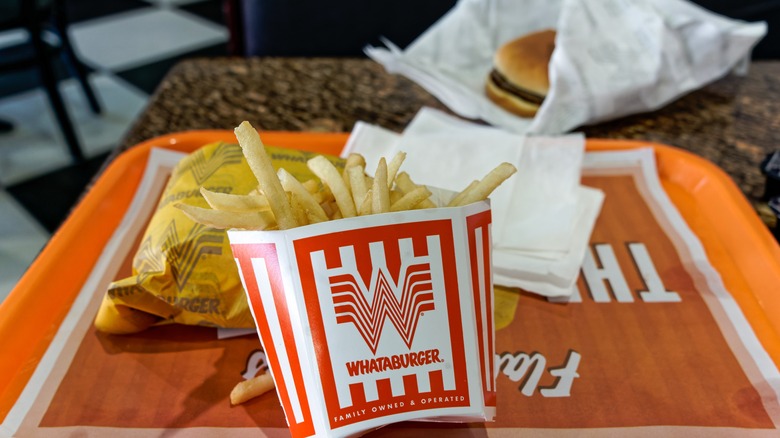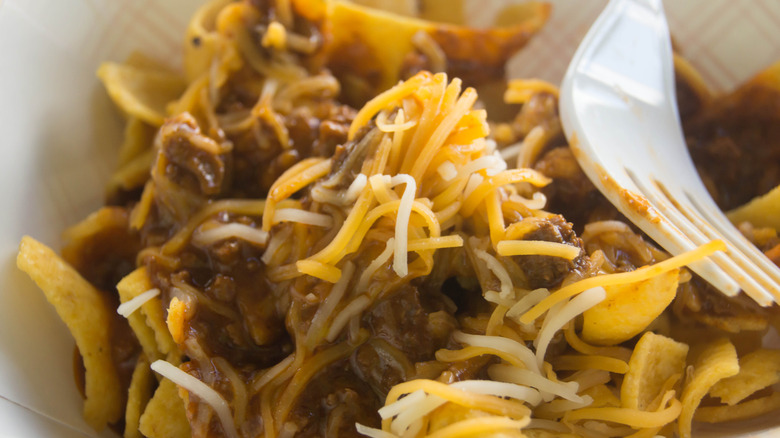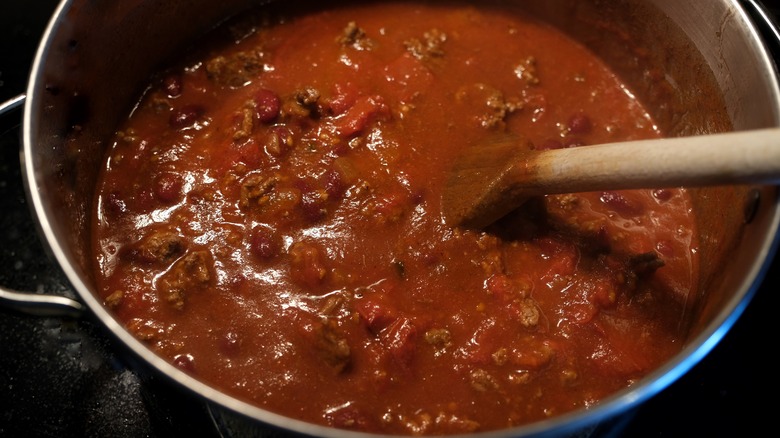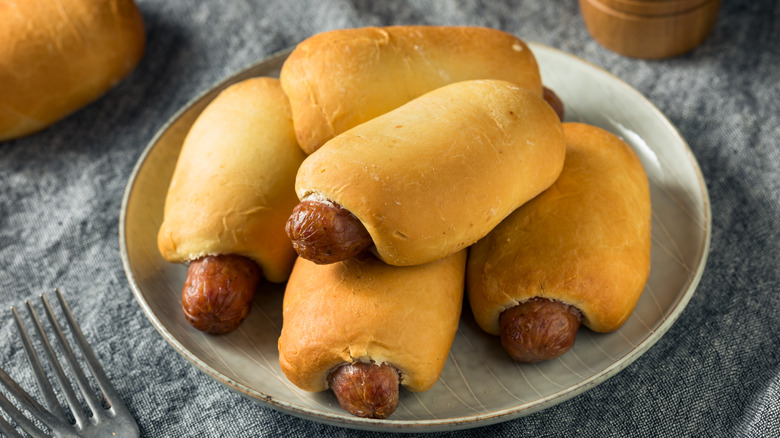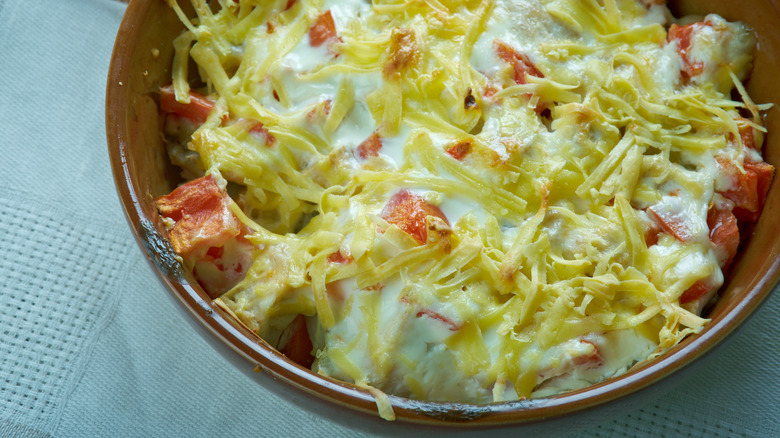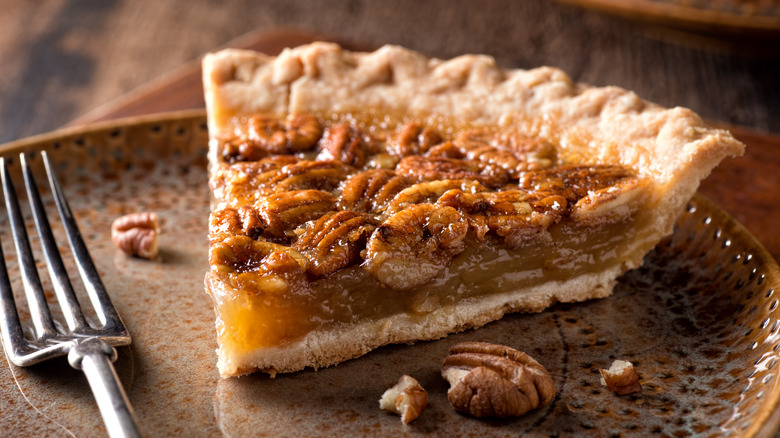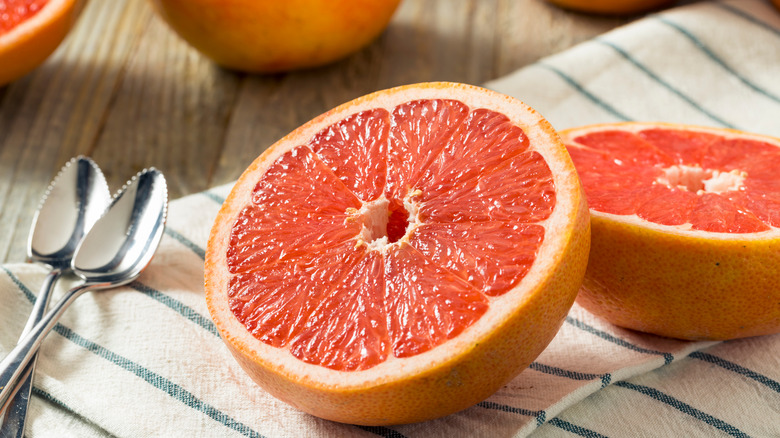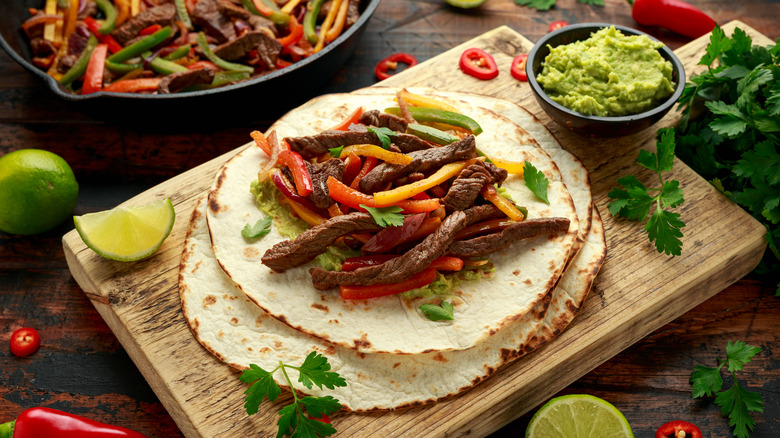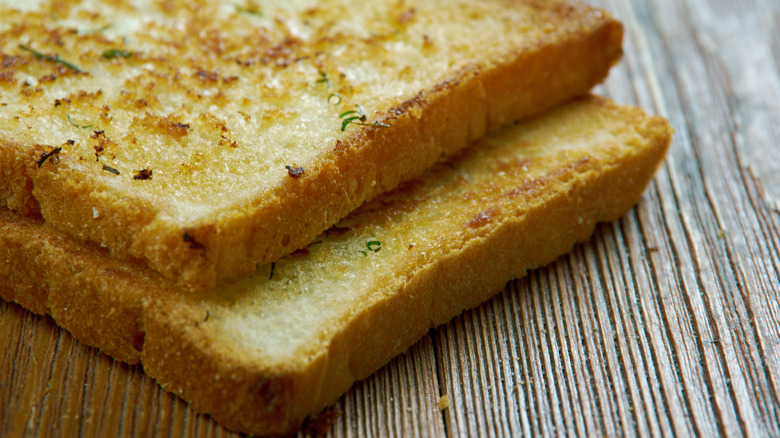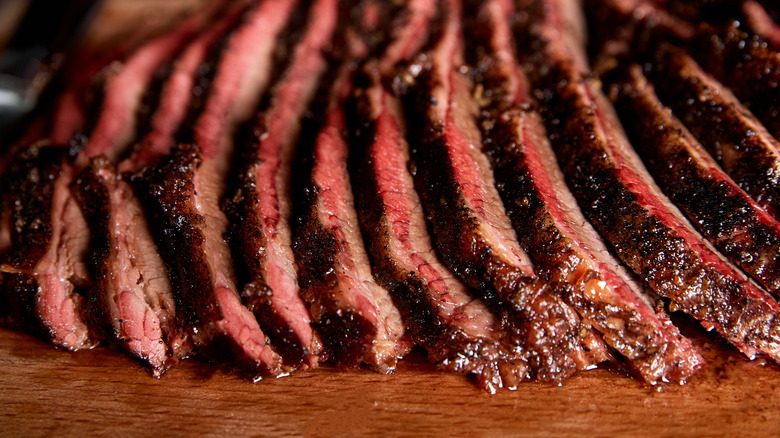16 Iconic Foods That Originated In Texas
You might be surprised to hear that the now-widespread slogan "don't mess with Texas" started as an anti-litter campaign (via Smithsonian). Given the amount of pride many Texans feel about the state, from history to heritage, it's no wonder this slogan stuck; it permeates much of the state's culture.
The same amount of pride also extends to the state's food culture. There is so much to love, from the state's history of smokehouses and barbecues to its Tex-Mex and bakeries, all thanks to the numerous cultures and communities that have called the Lone Star State home. According to a 2018 study published by Hays Free Press, Texas ranks second among states in the nation for cultural diversity. These diverse backgrounds show up in the mouthwatering dishes and traditions found here.
Many food traditions that are now eaten with gusto on a national level have come out of Texas. Here are some of those traditions and dishes, born deep in the heart of Texas, then spreading like wildfire across state lines.
Chicken fried steak
Many Texans would agree that you have not lived until you have tried a Texan chicken fried steak. The thought of it alone screams Texan diner or truck stop, known for their hearty portions and rib-sticking dishes. Depending on the time of day it's being consumed, chicken fried steaks, also known as country fried steaks, come slathered in a cream gravy made from drippings and a heavy-handed helping of mashed potatoes and greens for dinner or hash browns and fried eggs as breakfast.
The origins of this dish include the cooking traditions brought over to the U.S. by German and Austrian immigrants, which is why it so closely resembles a schnitzel — only amplified, as is the Texan way (via Britannica).
The dish has since left its Texas origins, served widely and joyfully throughout the American South. According to Michelle McGlinn's recipe for chicken fried steak, the trick is to go for cube steaks, which almost resemble ground beef, to ensure a thin and tender bite. It's a fun dish that practically oozes Texan charm, and is worth trying at home no matter where you live.
Texas funeral cake
Though it's a subject many are understandably reluctant to talk about, there are many traditions around what is served and eaten during funerals. Even in the saddest of times, everyone has to eat, and often it becomes the responsibility of the community to do the feeding. When attending a funeral in Texas, showing up with a giant chocolate sheet cake topped with a thick layer of frosting and studded with Texas-grown pecans, is a common tradition. So common, in fact, that many still refer to the baked good as a Texas funeral cake even when serving or eating it in other situations or settings.
This cake, known for its size, creamy buttermilk-enriched sponge, gooey texture, and decadent chocolaty flavor, sits alongside several Texas staples like King Ranch Chicken Casserole and smoked brisket on Houston Press's list of most comforting funeral foods. The texture, says Atlas Obscura, is made by poking holes into the fresh-from-the-oven sponge and then icing the cake while still warm.
Frozen margaritas
Almost nothing is better than a cold margarita on a hot day or accompanying a delicious Mexican meal. While the popular drink made from tequila, lime juice, and Triple Sec or Cointreau originated in Mexico, it was in Dallas, Texas, where Mariano Martinez, owner of Mariano's Hacienda, changed the way margaritas were consumed.
Though margaritas on the rocks have been around since the 1930s and frozen margaritas became popular in the 1970s, Martinez is celebrated for helping to bring frozen margaritas to the masses. Inspired by the easy access of the ubiquitous Slurpee machine, he used a run-down soft serve ice cream machine to help create the brain freeze-inducing glorious frozen margarita machine (via Culture Trip). Sadly, he couldn't patent his creation before others rushed to duplicate it. However, whenever you're in Dallas, Texas, you can still stop by Mariano's Hacienda for your frozen bev and tip your gallon-sized cowboy hat to the man who brought the frozen margarita machine to the world, all thanks to ingenuity and blazing hot Texan summers.
Queso
Queso, a beloved dish of Texas, would not be possible were it not for milk-producing livestock like cows and goats, brought by the Spanish conquistadors who made their way up and into El Paso through Mexico.
According to Food Republic, queso, though in existence, was not called as such within Mexican cookbooks. The first recipe to be published under a similar title was in a magazine titled "The Land of Sunshine," which ran out of Los Angeles, California. The dish was considered a side rather than the main event and included green chiles, tomatoes, and cheese. From there, the U.S. turned its dairy-facing focus to European food trends like fondue and rarebit. Later a Kentucky newspaper published a recipe for that added chilis to rarebit and versions of the spiced dish began to catch on. Chile con queso appeared on restaurant menus in San Antonio in 1910, with versions published within the "Women's Club Cook Book of Tested and Tried Recipes" in the early 1920s. However, rather than chunks of whole Mexican chiles in the dish, they were replaced with powered cayenne and paprika and specifically added "American" cheese products like Velveeta. Twenty years later, the product was so successful it was first canned commercially in Elsa, Texas.
Though the dish itself changes from the more Mexican to the more American-leaning versions based on the region in which it's consumed, velvety queso has become a popular appetizer served alongside a mountain of tortilla chips for dipping.
Whataburger
In 1950, Whataburger grilled and served its first hamburger out of a portable building in Corpus Christi. Its grand opening earned a profit of only $50. A few days later, their earnings had quadrupled, and the business has been growing ever since. Whataburger became the hamburger hotspot in Texas (via My San Antonio).
Whataburger is to Texas much like In-N-Out Burger is to Southern California — you simply cannot visit without making an obligatory stop. Want to double down on your ode to all things Texan with your order? Chron suggests slurping down a glass of the burger chain's Dr Pepper Shakes or ordering their Buffalo ranch chicken strip sandwich or patty melt; each comes sandwiched between two thick and grilled slices of Texas toast.
In 2019, the famous Texan burger chain went through some dramatic shifts. Official ownership changed hands to a Chicago-based investment firm, however, that doesn't stop it from being a much-loved source of Texas pride and dinner.
Dr Pepper
Though in Texas, you may still have to order it first as a 'coke' and then specify which kind, Dr Pepper was initially served out of Morrison's Old Corner Drug Store in Waco, Texas. It was a creation of pharmacist Charles Alderton who liked to create experiments by mixing carbonated beverages and syrups in his spare time. According to the Dr Pepper Museum (that's right, there's a whole museum dedicated to the soft drink), Alderton used his nose as the primary sensory lead, attempting to create a drink that tasted like the fruity scent of the drug store, a smell he adored. Customers soon ordered it by name, calling it the "Waco."
The popularity of the "Waco" syrup rose rapidly. It was so in demand by other soda fountain shops and businesses that Alderton and Wade Morrison, owner of Morrison's Old Corner Drug Store, couldn't keep up. The product, which had changed names to the now-familiar Dr Pepper, was handed off to a beverage chemist named Robert S. Lazenby to be eventually bottled and marketed in a variety of capacities, including as an "upper" and an antidote to increasing productivity during a mid-day slump, developing the slogan "the friendly Pepper-Upper."
Frito Pie
Who would have thought such a humble dish would be widely contested? A Frito pie, a comforting if not slightly guilty pleasure, is a mixture of Fritos corn chips, chili, onions, and cheese that can be served right from the bag of corn chips. Between the question of its origins (a lively debate between Texas and New Mexico) to the low-bar review initially given by the late Anthony Bourdain (which was thankfully corrected shortly after that, per the Los Angeles Times), the dish has undergone more scrutiny than some politicians.
Though New Mexicans would argue otherwise, according to the Houstonia and the findings from the 2011 released cookbook "Fritos Pie: Stories, Recipes, and More" it is likely that the origins of this dish came from Texas, just like Fritos. Frito pie, the book says, was first created in the Frito-Lay's test kitchen to be served to the Dallas Dietetic Association in 1949. Well, wonders never cease.
Sweet Tea
"Sweet tea isn't a drink, really. It's culture in a glass," writes West Virginia-raised Allison Glock (via Garden & Gun). It is a ubiquitous cultural touchstone and omnipresent within southern living and hospitality. Glock explains everyone has an opinion on how best to make it and where best to drink it. It also combines two magical ingredients — caffeine and sugar — that send everyone who drinks it buzzing while also legally able to drive or head back to work.
According to Texas Heritage for Living, the oldest written recipe for sweet tea was initially published in "Housekeeping in Old Virginia," written by Texas-born Marion Cabell Tyree in 1879. However, what might shock many Texans and Southerners is that Tyree uses green tea rather than black tea, as was the fashion at the time. Though an everyday staple throughout all classes and cultures of the American South, sweet tea was once associated with the upper class and elite due to the expense of both ice and sugar required to make it.
Red chili or chili con carne
Whatever you do, please do not place a bowl filled with beef chili that's studded with kidney beans in front of a Texan and call it a Texan red chili. Or, if you do, come be prepared to defend yourself — Texans do not mess around when it comes to this dish and their unwavering "no beans" stance. This Tex-Mex classic has spent more than 40 years as the official state dish, according to Texas Monthly.
The dish's origin, however, has a surprising number of variations, from a mysterious nun in Spain known as La Dame de Azul who wrote down the first never-to-be-found recipe to two Texan cowboys who needed a hearty staple to sustain them while traveling, even claims from those incarcerated in Texan prison to have started the dish out of necessity (via What's Cooking America). Texas food historian Robb Walsh believes that the dish came to San Antonio with the migration of a Canary Island community known as the Isleños.
Despite its muddled origins, what is clear is the influence of the San Antonio Chili Queens, who, just after the Civil War, spent their time making vats of chili filled with meat, chilies, and spices, then dragging their pots into the plazas to feed soldiers and customers. Though eventually shut down due to government-mandated and prohibitively expensive sanitary standards and facilities, their legend lives on, with revivals and re-enactments of the queens and their reign in San Antonio.
Kolaches
What do you get when you cross Czech traditions with Texan sensibilities? The answer is a unique kolache you can't find anywhere else. Visit what the New York Times references as Texas's "Czech Belt," which sweeps across central Texas, to find a variety of artisan bakeries and doughnut shops that have taken these Czech-originating pastry traditions and revamped either sweetened cheese or fruit-filled pastries with alternative, often savory fillings like sausages, sauerkraut, and even jalapeño cheese.
The trend proved so popular that businesses like the Kolache Factory, which opened in 1982 and dedicated itself to the product, have gone on to open successful outlets, now more than 30 of them, in other states too. The tradition has developed such strong roots that a new generation of kolache bakers has grown from it. Autumn Stanford told the New York Times that her family's background isn't Czech. Stanford was born and raised in Austin and grew up eating the Texan version of kolache. When she moved to Brooklyn, New York, she took the now Texan tradition with her and is now the owner of the Brooklyn Kolache Company.
King Ranch chicken casserole
Want to eat several Tex-Mex staples in one creamy, comforting forkful? You better get a plate of Lone Star's favorite casserole, the King Ranch. Like many casserole dishes of their time, King Ranch is made with the help of convenience foods like cream of mushroom soup. Its ingredients list reads like a Tex-Mex bingo card. Pulled chicken, sweet corn, chopped canned tomatoes, green chiles, and corn tortilla chips are mixed, then topped with a layer of melted cheddar cheese. Like any good casserole, it cleverly brings together a few ingredients, often coupled with leftovers, to create a family meal that feels intentional and tastes more than the sum of its parts. It, too, was named as one of Houston Press's most comforting funeral foods.
The hearty casserole's connection to its name, referencing the largest ranch in Texas, remains a mystery. Perhaps it is a secret reference to the size of appetite you'll need to manage more than one plateful of the filling dish. Whatever the history, the dish has secured a place in just about every Texan's heart.
Pecan pie
We think the phrase "as American as apple pie" should be amended to "as American as pie." The country is obsessed. According to the American Pie Council's list of fun facts circa 2008, if you were to line up the number of pies sold within American grocery stores in just one year alone, the pie trail would be longer than the circumference of the world. That's a lot of pie!
Given the nationwide love of pie, it makes sense that Texans have a longstanding history of using this baked good to celebrate one of the state's native pecan trees. In 1919, the pecan tree was officially named Texas's state tree, growing over 20% of the nation's pecan supply (via Capitol Texas). However, as self-proclaimed pecan pie enthusiast Edgar Rose told Eater, earlier versions of the pecan pie recipes had appeared in Texan cookbooks since the 1870s, with a more recognizable version first printed in a church cookbook in St. Louis in 1898, submitted of course by a Texan. However, until corn syrup brand Karo incorporated their product into the pie in the 1920s, the dish took off nationally. In 2013, pecan pie became the official state pie of Texas, telling the world that Texas loved it first and best.
Ruby red grapefruit
The history of citrus fruit in America is a long and winding tale, likely brought over originally as seeds by Spanish and French settlers. Citrus fruits like oranges and grapefruit were first grown in Florida, according to Texas A&M AgriLife Extension Service. However, they soon migrated, thriving when grown in similarly warm and humid climates with sandy soil, like that in Texas.
The ruby red grapefruit is known and named for its color, distinctive in both its vibrant coral flesh and its golden skin. This unique variety came about as a naturally occurring mutation on what was intended to be a pink grapefruit tree on the McAllen orchard in 1929 (via Texas Monthly). In 1934, the name "Ruby Red" was patented, forever to be attributed to the great state of Texas and now the state's official fruit.
Not only are ruby reds refreshingly juicy and a source of Texan pride, but they are also bursting with immune-supporting vitamin C and vitamin A and are rich in antioxidants and fiber, says Healthline, making them a great choice in Texas and elsewhere, too.
Fajitas
At least once every five minutes or so, all around the country, there must be a skillet of sizzling fajitas being wheeled out to hungry dinners, served with warnings not to touch the plate. Even just writing about fajitas can induce cravings! According to The Local Palate, this classic Tex-Mex favorite started in a small tortilleria in Houston owned by María Ninfa Rodríguez Laurenzo, aka Mama Ninfa.
A byproduct of innovation and tough times, Mama Ninfa began serving versions of this dish to increase the profits of her tortilleria enough to feed her family, turning the front room of the factory into a makeshift restaurant. First, Mama Ninfa served a pre-assembled version of fajitas, known as tacos al carbon, which means the ingredients were cooked over coals. Eventually, Mama Ninfa transitioned to include a make-your-own style of tacos which used a cut of beef called skirt steak, or faja in Spanish, thus inspiring the name of the now widely known dish and cementing Nina's as a much-loved institution deep in the heart of Texas.
Texas toast
The only complaint one could make about Texas toast is that it's too wonderfully thick to slide into the average-sized toaster. Royce Hailey, manager of the Pig Stand in Beaumont, Texas — which claims to be the originator of Texas toast — is to thank. The chain restaurant was once massive, with over 100 locations across the state and beyond, but has sadly now been reduced to one in San Antonio (via Garden & Gun).
Apparently, Hailey wanted thicker bread slices to go alongside the Pig Stand's signature fish and chips and asked the bread company if they could slice it differently. The only means to cook it was to butter both sides generously, then pop it on the grill. Behold, Texas toast was born. Beloved for its thickness, it is the perfect means to mop up and last drips of gravy or sauce, which is why it is an excellent accompaniment to Texas barbecue, eggs, and bacon, or soak up maple syrup when turned into French toast.
Smoked brisket
You might be surprised to hear that the first known sale of the peppery, smoker-kissed brisket out of Texas was not at the local barbecue joint but at the Jewish deli. Though there may have been plenty of word-of-mouth smokehouses slinging the stuff, the first recorded product advertisement came from the state's Jewish delis in 1910 (via Texas Monthly). It wasn't until the 1950s that smoked brisket was found in barbecue restaurants, with Black's Barbecue claiming to be the first.
Brisket, made from the tougher and then considered less desirable cuts of meat, has become an affordable staple within Ashkenazi Jewish culture, cooked low and slow to tenderize before being served on Shabbat, Rosh Hashanah, or other holidays. Its cost-effectiveness was an attractive attribute for the Jewish communities that had immigrated to the state in the 1800s and cattle ranchers. Given the size of the beef industry in Texas, it was only a matter of time before these communities overlapped and the smoked brisket was born.
